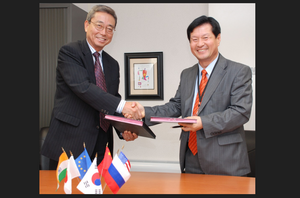Korea signs procurement for assembly tools
Even after more than 4,500 years its power to fascinate has not diminished. Classified as one of the Seven Wonders of the World, the Cheops Pyramid remains one of the most intriguing monuments ever built by human hands. Hands that were in fact pretty much the only tools available for lifting rocks weighing nearly 2.5 tonnes, besides ropes made from palm fibre, grass and papyrus, plus "machines made of short pieces of wood," as the famous Greek historian Horodotus reported.
It would be terrific to be able to read what the historians will write about ITER in 1,000 years or more. What will they think of the tools that were developed for the assembly of the tokamak? Tools for ITER's XXL parts will be capable of lifting components as tall as six stories high and as heavy as 360 tonnes—the lift-off weight of a Boeing 747-300. Will they look back to that prototype fusion machine with the same fascination as we look at these "monuments of eternity" in Egypt?
One hundred and sixty-one different types of custom tools will be required to assemble, lift and finally manoeuver ITER's supersized components such as the toroidal field coils from the Assembly Hall to the Tokamak Pit. Their loading capacities will vary from between 500 tonnes for the upending tool that will turn components from horizontal to vertical, to 1,500 tonnes for the heavy lifting tools and main assembly cranes that will be used to lift the nine 40° sectors of the vacuum vessel into the Tokamak Pit for their final assembly. There, the biggest tool in the assembly set will finally grasp all nine sectors together—an impressive 3,800 tonnes—in order to align the vessel structure one last time. While the purchase of the standard tools for ITER assembly will be paid out of a common fund, South Korea will develop and manufacture the customized tools as part of its in-kind procurement to ITER. The Assembly Tool Procurement Arrangement signed Monday, 3 August between the ITER Organization and Korea at ITER Headquarters is worth about EUR 34 million.
"We are very proud to sign this Procurement Arrangement today," said Kijung Jung, the Director of the Korean Domestic Agency, following the signature. "Meeting the target date for this procurement will allow the ITER Organization to continue with its overall schedule and the goal of First Plasma in 2018." Together with the signature for its contribution to ITER's toroidal field conductors, the vacuum vessel itself and the equatorial and lower ports, Korea has now signed for 61.7 percent of its total in-kind contributions adding up to EUR 230 million.



